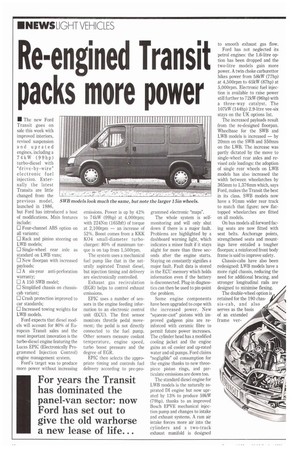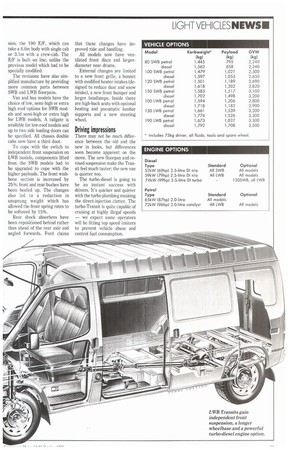Re-engined Transit packs more power
Page 12

Page 13

If you've noticed an error in this article please click here to report it so we can fix it.
• The new Ford Transit goes on sale this week with improved interiors, revised suspension and uprated engines, including a 74 kW (99hp) turbo-diesel with "drive-by-wire" electronic fuel injection. Externally the latest Transits are little changed from the previous model, launched in 1986, but Ford has introduced a host of modifications. Main features include: 0 Four-channel ABS option on all variants; 0 Rack and pinion steering on LWB models; 0 Single-wheel rear axle as standard on LWB vans;
LI New floorpan with increased payloads; LIA six-year anti-perforation warranty;
LI A 150 SWB model; LI Simplified chassis on chassiscab variant; D Crash protection improved to car standards; LI Increased towing weights for LWB models.
Ford expects that diesel models will account for 8096 of European Transit sales and the most important innovation is the turbo-diesel engine featuring the Lucas EPIC (Electronically Programmed Injection Control) engine management system.
Ford's target was to produce more power without increasing emissions. Power is up by 42% to 74kW (99hp) at 4,000rpm; with 224Nm (1651bft) of torque at 2,100rpm — an increase of 52%. Boost comes from a KKK K04 small-diameter turbocharger: 80% of maximum torque is on tap from 1,500rpm.
The system uses a mechanical fuel pump like that in the naturally aspirated Transit diesel, but injection timing and delivery are electronically controlled.
Exhaust gas recirculation (EGR) helps to control exhaust emissions.
EPIC uses a number of sensors in the engine feeding information to an electronic control unit (ECU). The first sensor monitors throttle pedal movement; the pedal is not directly connected to the fuel pump. Other sensors measure coolant temperature, engine speed, turbo boost pressure and the degree of EGR.
EPIC then selects the appropriate timing and controls fuel delivery according to pre-pro
grammed electronic "maps".
The whole system is selfmonitoring and will only shut down if there is a major fault. Problems are highlighted by a dashboard warning light, which indicates a minor fault if it stays alight for more than three seconds after the engine starts. Staying on constantly signifies a major fault. Fault data is stored in the ECU memory which holds information even if the battery is disconnected. Plug-in diagnostics can then be used to pin-point the problem.
Some engine components have been upgraded to cope with the increased power. New "squeeze-cast" pistons with improved gudgeon pins are reinforced with ceramic fibre to permit future power increases. The cylinder head has a modified cooling jacket and the engine gains an oil cooler and up-rated water and oil pumps. Ford claims "negligible" oil consumption for the engine thanks to new threepiece piston rings, and particulate emissions are down too.
The standard diesel engine for LWB models is the naturally aspirated DI engine but now uprated by 13% to produce 59kW (79hp), thanks to an improved Bosch EPVE mechanical injection pump and changes to intake and exhaust systems. A ram air intake forces more air into the cylinders and a two-track exhaust manifold is designed to smooth exhaust gas flow.
Ford has not neglected its petrol engines: the 1.6-litre option has been dropped and the two-litre models gain more power. A twin choke carburettor hikes power from 58kW (77hp) at 4,500rpm to 65kW (87hp) at 5,000rpm. Electronic fuel injection is available to raise power still further to 72kW (96hp) with a three-way catalyst. The 107kW (144hp) 2.9-litre vee-six stays on the UK options list.
The increased payloads result from the re-designed floorpan. Wheelbase for the SWB and LWB models is increased — by 20mm on the SWB and 550mm on the LWB. The increase was partly dictated by the move to single-wheel rear axles and revised axle loadings: the adoption of single rear wheels on LWB models has also increased the width between wheelarches by 365mm to 1,376mm which, says Ford, makes the Transit the best in its class. SWB models now have a 91mm wider rear track to match that figure: new flattopped wheelarches are fitted on all models.
On bus models all forward facing seats are now fitted with seat belts. Anchorage points, strengthened seats and mountings have entailed a tougher floorpan; a reinforced front body frame is said to improve safety.
Chassis-cabs have also been redesigned: LWB models have a more rigid chassis, reducing the need for additional bracing, and stronger longitudinal rails are designed to minimise flexing.
The double-wheel option is retained for the 190 chassis -cab, and also serves as the basis of an extended frame ver sion, the 190 E/F, which can take a 4.0m body with single cab or 3.1m with a crew-cab. The E/F is built on line, unlike the previous model which had to be specially modified.
The revisions have also simplified manufacture by providing more common parts between SWB and LWB floorpans.
Van and bus models have the choice of low, semi-high or extra high roof options for SWB models and semi-high or extra high for LWB models. A tailgate is available for low-roof models and up to two side loading doors can be specified. All chassis double cabs now have a third door.
To cope with the switch to independent front suspension on LWB models, components lifted from the SWB models had to be upgraded to cope with the higher payloads. The front wishbone section is increased by 25%; front and rear bushes have been beefed up. The changes also led to a reduction in unsprung weight which has allowed the front spring rates to be softened by 15%.
Rear shock absorbers have been repositioned behind rather than ahead of the rear axle and angled forwards. Ford claims that these changes have improved ride and handling.
All models now have ventilated front discs and largerdiameter rear drums.
External changes are limited to a new front grille, a bonnet with modified heater intakes (designed to reduce dust and snow intake), a new front bumper and larger headlamps. Inside there are high-back seats with optional heating and pneumatic lumbar supports and a new steering wheel.
Driving impressions
There may not be much difference between the old and the new in looks, but differences soon become apparent on the move. The new floorpan and revised suspension make the Transit feel much tauter; the new van is quieter too.
The turbo-diesel is going to be an instant success with drivers. It's quicker and quieter with the turbo plumbing masking the direct-injection clatter. The turbo-Transit is quite capable of cruising at highly illegal speeds we expect some operators will be fitting top speed limiters to prevent vehicle abuse and control fuel consumption.
































































































